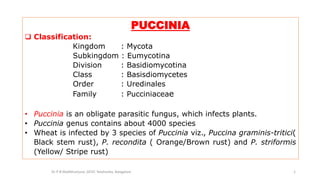
Puccinia
- 1. PUCCINIA Classification: Kingdom : Mycota Subkingdom : Eumycotina Division : Basidiomycotina Class : Basisdiomycetes Order : Uredinales Family : Pucciniaceae • Puccinia is an obligate parasitic fungus, which infects plants. • Puccinia genus contains about 4000 species • Wheat is infected by 3 species of Puccinia viz., Puccina graminis-tritici( Black stem rust), P. recondita ( Orange/Brown rust) and P. striformis (Yellow/ Stripe rust) Dr P B Mallikharjuna ,GFGC Yelahanka, Bangalore 1
- 2. • Puccinia graminis - tritici is the most common species • It causes black - stem rust disease in Wheat, an important staple crop. Puccinia graminis- tritici It is an obligate parasitic fungus, In the absence of living host tissue, they survive as spores It is a macrocyclic, diphasic, polymorphic and heteroecious fungus. Dr P B Mallikharjuna ,GFGC Yelahanka, Bangalore 2 Uredosori Teleutosori Pycnia Acedia
- 3. Macrocyclic fungus : It produces all types of spores (5 types) 1. UREDOSPORES (Asexual stage) 2. TELEUTOSPORES (Sexual apparatus / Resting spore) 3. BASIDIOSPORES, 4. PYCNIDIA- (Spermogonium- the Sexual Reproductive Stage) 5. AECIOSPORES-(Sexual stage) Diphasic fungus: It’s mycelium exists in both monokaryotic and dikaryotic mycelial stages during its life cycle. Heteroecious: It completes its life cycle in two living host plants viz., 1)WHEAT: edible crop, monocot, (Triticum aestivum) - (The primary host) and 2)BARBERY: secondary host; dicot - weed ( Berberis vulgaris) Dr P B Mallikharjuna ,GFGC Yelahanka, Bangalore 3
- 4. Puccinia on wheat: • Wheat rust is one of the major and most devastating disease of wheat across the globe • Puccinia will attack the entire wheat plant, especially the leaves and stem. • Its mycelium is filamentous, multicellular, highly branched, dikaryotic, intercellular with haustoria • It produces two types of sporal stages in the wheat host. 1. Uredospores :The first spores to infect the young wheat plants in the fall /summar are urediniospores. and 2. Teleutospores :Resting spores Dr P B Mallikharjuna ,GFGC Yelahanka, Bangalore 4
- 5. 1.UREDOSPORES: • This sporal stage is the prevalent stage generally called Uredosorus. • It represents the asexual reproduction stage • These are long streaked red coloured pustules, most commonly appear on the wheat leaves and stems to some extant. Uredospores are usually ovoid in shape, single celled, stalk bearing, thick walled spores. It is a binucleate cell with the two layered wall. The outer layer is thick and spiny, where as inner layer is thin and smooth. 4 - germ pores are present on its equatorial zone. They are produced in the Uredinium or Uredosorus (50,000- 400000spores/ uredinium) Dr P B Mallikharjuna ,GFGC Yelahanka, Bangalore 5
- 6. 2. TELEUTOSPORES: • Teliospores are produced in a telium. • Elongated blackish brown coloured pustules produced more on the stem and leaf sheath region. Teleutospores are bicelled , stalked, spindle shaped, blackish -brown coloured with bilayered thick and smooth wall. Each cell is a binucleate and single germ aperture containing structure It is a resting spore, which represents the sexual apparatus in which karyokinesis and meiosis occurs later. TS of Wheat stem showing the Telutosorus of Puccinia Telutospore Dr P B Mallikharjuna ,GFGC Yelahanka, Bangalore 6
- 7. 3. BASIDIOSPORES: the infected dried wheat straw containing teleutospores will germinate during favourable conditions and produces a 4- celled Promycelium. Later, each cell of the promycelium produces a basidiospore. Dr P B Mallikharjuna ,GFGC Yelahanka, Bangalore 7
- 8. PUCCINIA ON BARBERY 1.It establishes in the Barbery plant by the germination of Basidiospores. 2.Its mycelium usually present in the leaf region. 3.It is the primary and initially monokaryotic mycelium usually confined to the upper portion of the leaf 4.This fungus will produces two sporal stages on the leaf i.e., the pycnidial stage on the upper surface and the acedial stage towards the lower surface Dr P B Mallikharjuna ,GFGC Yelahanka, Bangalore 8
- 9. Dr P B Mallikharjuna ,GFGC Yelahanka, Bangalore 9
- 10. VS of Barbery leaf with Puccinia Dr P B Mallikharjuna ,GFGC Yelahanka, Bangalore 10
- 11. THE PYCNIDIUM : After a few days, Puccinia will undergo sexual reproduction called Spermatogamy. Spermatogamy takes place between two spermogia or pycnidial cups belongs to two different types (+, -) A typical spermogonium or pycnidial cup is usually possess numerous finger like spermatophores in the middle portion surrounded by a long branched tubular receptive hyphae. Spermatiophores are considered as the male structures, which produce spermatia or male gametes While, the receptive hypha is considered to be the female reproductive structure with a basal nucleus. When the spermatia is fallen on the receptive hypha, its nucleus penetrate into the basal portion of the hypha and lie besides the female nucleus, it is known as Diplodization ( Fertilization) Dr P B Mallikharjuna ,GFGC Yelahanka, Bangalore 11
- 12. ACEDIOSPORES: The dikaryotic mycelium is resulted due to the diploidzation of the monokaryotic hyphae, which grow towards the lower epidermis and establishes into the aeciospores. AECIOSPORES Dr P B Mallikharjuna ,GFGC Yelahanka, Bangalore 12
- 13. Dr P B Mallikharjuna ,GFGC Yelahanka, Bangalore 13
